Operator`s Manual
Tamp Applicator
1300
�
2
Operator's Manual - Translation of the Original Version
for the following products
Description
Type
Part.-No.
5941000
5941001
5941100
5941131
Tamp Applicator
Tamp Applicator
Tamp Applicator
Tamp Applicator
1300L-220H
1300L-300H
1300R-220H
1300R-300H
2
Edition: 03/2010 - Part.-No. 9008170
Copyright
This documentation as well as translation hereof are property of cab Produkttechnik GmbH & Co. KG.
The replication, conversion, duplication or divulgement of the whole manual or parts of it for other intentions than its original
intended purpose demand the previous written authorization by cab.
Trademark
Centronics® is a registered trademark of the Data Computer Corporation.
Microsoft® is a registered trademark of the Microsoft Corporation.
Windows 2000®, 2003®, XP® are registered trademarks of the Microsoft Corporation.
TrueTypeTM is a registered trademark of Apple Computer, Inc.
Editor
Regarding questions or comments please contact cab Produkttechnik GmbH & Co. KG.
Topicality
Due to the constant further development of our products discrepancies between documentation and product can occur.
Please check www.cab.de for the latest update.
Terms and conditions
Deliveries and performances are effected under the General conditions of sale of cab.
Germany
cab Produkttechnik
GmbH & Co KG
Postfach 1904
D-76007 Karlsruhe
Wilhelm-Schickard-Str. 14
D-76131 Karlsruhe
Telefon +49 721 6626-0
Telefax +49 721 6626-249
www.cab.de
info@cab.de
France
cab technologies s.a.r.l.
F-67350 Niedermodern
Téléphone +33 388 722 501
www.cab.de
info@cab-technologies.fr
España
cab España S.L.
E-08304 Montaró (Barcelona)
Teléfono +34 937 414 605
www.cab.de
info@cabsl.com
USA
cab Technology Inc.
Tyngsboro MA, 01879
Phone +1 978 649 0293
www.cabtechn.com
info@cabtechn.com
South Afrika
cab Technology (Pty.) Ltd.
2125 Randburg
Phone +27 11-886-3580
www.cab.de
info@cabtechn.co.za
Representatives in other countries on request.
Asia
cab Technology Co, Ltd.
Junghe 23552, Taipei, Taiwan
Phone +886 2 8227 3966
www.cabasia.net
cabasia@cab.de
cab (Shanghai) Trading Co.,Ltd
2299 11C60
Phone +86 21 6236-3161
cabasia@cab.de
�
Table of Contents
3
1
1.1
1.2
1.3
1.4
1.5
2
2.1
2.2
Introduction ............................................................................................................................................ 4
Instructions ............................................................................................................................................... 4
Intended Use ............................................................................................................................................ 4
Safety Instructions .................................................................................................................................... 4
Safety Marking ......................................................................................................................................... 5
Environment ............................................................................................................................................. 5
Product Description ............................................................................................................................... 6
Function ................................................................................................................................................... 6
Device Overview ...................................................................................................................................... 7
3
Installation .............................................................................................................................................. 8
3.1
Delivery Of The Applicator ....................................................................................................................... 8
3.2 Mounting Applicator .................................................................................................................................. 8
3.2.1 Attach Applicator At Printer ...................................................................................................................... 8
3.2.2 Connections ............................................................................................................................................. 9
3.2.3 Mounting maintenance unit (Option) ........................................................................................................ 9
4
Adjustments ......................................................................................................................................... 10
4.1 Mechanical Adjustments ........................................................................................................................ 10
4.1.1 Adjustment - Pad Position ..................................................................................................................... 10
4.1.2 Adjustment the angle of the pad in the take over position ......................................................................11
4.1.3 Adjust the level of the cylinder assembly ................................................................................................11
4.1.4 Adjustment - Air Tube ............................................................................................................................. 12
4.2
Pneumatic Adjustments .......................................................................................................................... 12
4.2.1 Set Valves .............................................................................................................................................. 12
4.2.2 Slide Valve ............................................................................................................................................. 12
4.2.3 Throttle Valves At The Valve Block ......................................................................................................... 13
4.2.4 Throttle Valve At The Cylinder ................................................................................................................ 13
Operation .............................................................................................................................................. 14
5
5.1
Setting The Operating Mode And Delay Times ...................................................................................... 14
5.1.1 DIP-Switches .......................................................................................................................................... 14
5.1.2 Potentiometer ......................................................................................................................................... 14
5.1.3 Read Settings Of Potentiometers ........................................................................................................... 15
5.1.4 Operating Mode ..................................................................................................................................... 15
Pre-Dispense Key .................................................................................................................................. 16
5.2
Peel Position .......................................................................................................................................... 17
5.3
5.4
Normal Operation ................................................................................................................................... 17
6
6.1
6.2
6.3
7
7.1
7.2
8
9
9.1
9.2
10
PLC Interface ........................................................................................................................................ 18
Comments On The Signals .................................................................................................................... 18
Circuit Diagrams Of Inputs And Outputs ................................................................................................ 20
Examples For Circuits To Creating An External Start Signal .................................................................. 21
Error Messages .................................................................................................................................... 23
Printer Error Messages ......................................................................................................................... 23
Applicator Error Messages ..................................................................................................................... 23
Function Of The LED's On The PCB ................................................................................................... 24
Declaration ............................................................................................................................................ 25
EC Declaration of Incorporation ............................................................................................................. 25
EC Declaration of Conformity ................................................................................................................. 26
Index ...................................................................................................................................................... 27
�
4
1
Introduction
4
1.1
Instructions
Important information and instructions in this documentation are designated as follows:
Danger!
Draws your attention to an exceptionally grave, impending danger to your health or life.
!
!
i
Warning!
Indicates a hazardous situation that could lead to injuries or material damage.
Attention!
Draws attention to possible dangers, material damage or loss of quality.
Notice!
Gives you tips. They make a working sequence easier or draw attention to important working processes.
Environment!
Gives you tips on protecting the environment.
Handling instruction
Reference to section, position, illustration number or document.
Option (accessories, peripheral equipment, special fittings).
Zeit Information in the display.
1.2
Intended Use
• The device is manufactured in accordance with the current technological status and the recognized safety rules.
However, danger to the life and limb of the user or third parties and/or damage to the device and other tangible
assets can arise during use.
• The device may only be used for its intended purpose and if it is in perfect working order, and it must be used with
regard to safety and dangers as stated in the operating manual.
• The device is developed to work in a system with a Hermes A printer
• The device applicator is intended exclusively for labeling suitable materials that have been approved by the
manufacturer. Any other use or use going beyond this shall be regarded as improper use. The manufacturer/
supplier shall not be liable for damage resulting from unauthorized use; the user shall bear the risk alone.
• Usage for the intended purpose also includes complying with the operating manual, including the manufacturer‘s
maintenance recommendations and specifications.
i
Notice!
The complete documentation is currently in the Internet.
1.3
Safety Instructions
• Only connect the device to other devices which have a protective low voltage.
• Switch off all affected devices (computer, printer, accessories) before connecting or disconnecting.
• The device may only be used in a dry environment, do not expose it to moisture (sprays of water, mists, etc.).
!
!
Warning!
Make sure that the printer is disconnected from the power supply and the valve at the service unit as well
as the shutoff valve at the applicator are closed, while installing the delivered components.
Warning!
In operation, moving parts are easily accessible. Therefore, keep long hair, loose clothes and jewelry
distant. Before any manipulations in those areas, close the shutoff valve.
�
1
Introduction
5
!
Warning!
Do not try to manipulate or repair parts they are not described in the manuals of the tamp applicator or the
printer.
1.4
Safety Marking
1:
Risk of injury by moved parts
1
Figure 1 Safety marking
1.5
Environment
Obsolete devices contain valuable recyclable materials that should be sent for recycling.
Send to suitable collection points, separately from residual waste.
The modular construction of the printer enables it to be easily disassembled into its component parts.
Send the parts for recycling.
The electronic circuit board of the device is equipped with a lithium battery.
�
6
2
Product Description
2.1
Function
6
The tamp applicator 1300 is an additional module for the transfer printer Hermes A. It's developed for the automati-
cally apply a label onto a product.
To apply the label the applicator used a Tamp, which moved between a take-over position and a labeling position by
two pneumatic cylinder.
In the take over position the tamp get the label from printer. In the take-over position, the label is picked up from the
printer by the vacuum plate of the pad. A sensor at the cylinder signals when the pad is in the take-over position.
The label is removed from the carrier ribbon directly at the dispense edge of the printer. It is sucked on the pad by
a vacuum via drill-holes at the bottom of the pad. For support, the label is also blown against the pad with an air
current coming from a blow tube. The correct transfer of the label is controlled by a vacuum sensor. Next, the pad is
moved down into the labelling position, which is confirmed by another sensor (labelling position sensor). Here, the
label is stamped onto the product. While the pad is moving back into the starting position, the vacuum sensor controls
whether the label has been removed from the pad. Specially adapted pads can be used for different label sizes.
While the pad is moving back into the starting position, the vacuum sensor controls whether the label has been
removed from the pad.
Supporting air, vacuum and cylinder speed are adjustable. So it's possible to accommodate the system to different
label sizes.
For operation in a superior system the applicator's PLC (programmable logic control) interface with potential free
inputs and outputs can be used..
Label transfer
Label width in mm
Label height in mm
Cylinder stroke in mm
Compressed air supply
Product surface
Product height
variable
fixed
Product
stationary
moving
rotating
Cycle time
Labeling per min.
Table 1
Technical data
Description of the tamp applicator
Stamp
80 - 116
80 - 200
100 - 400
0,5 - 0,6 MPa (5 - 6 bar)
flat
¢
-
¢
-
-
approx. 20
Type 1300(R) - yyy H
Orientation
Orientation : Decisive for direction of dispense
Stroke length : Decisive for the stroke length of the main cylinder
Length of the main cylinder in mm
with Left or Right orientation
Stroke length
for transfer printer Hermes
�
2
Product Description
2.2
Device Overview
View A
7
1
2
3
4
5
6
7
8
9
View B
10
Figure 2 Overview
1 Thumbscrew
2 Connector compressed air
3 Sensor "Takeover Position"
4 Main lift cylinder
5 Sensor
6 Lift cylinder for the tilting movement
7 Sensor "Labeling Position"
8 Tamp assembly
9 Blow tube
10 Connector applicator-printer
�
8
3
Installation
8
3.1
Delivery Of The Applicator
Check the applicator at transport damage and totality.
Scope of delivery:
• Applicator
• Pad and blow tube (customized)
• Hinges and screws
• Maintenance unit (option)
• Documentation
i
Notice!
Please keep the original packaging in case the printer must be returned.
3.2
!
!
Mounting Applicator
Attention!
Mounting and installation the applicator only if the printer switched of.
Warning!
Risk of injury and damage in case of using the applicator not appropriate.
Use the applicator only secure mounted at a Hermes A - printer.
3.2.1 Attach Applicator At Printer
1. Axle part of hinges (3) mount like Figure 3 .
2. Applicator hang with the female part (1) of hinges at the printer mounted hinges parts (3).
3. Connect SUB-D 15 male connector (5) to the female connector (6) of the printer.
4. Swing the applicator to the printer and tighten the thumbscrew (2).
1
2
3
4
1
5
6
Figure 3 Mounting and connecting
�
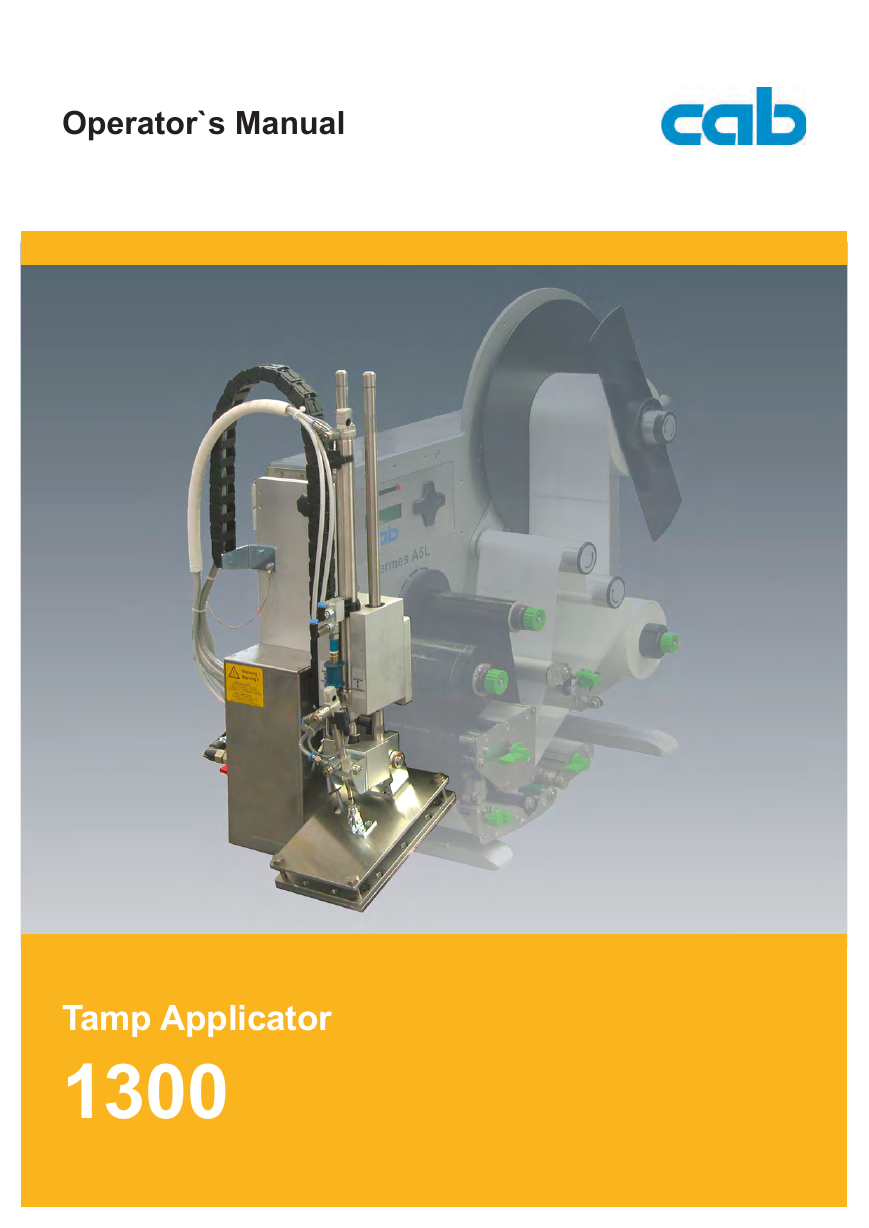
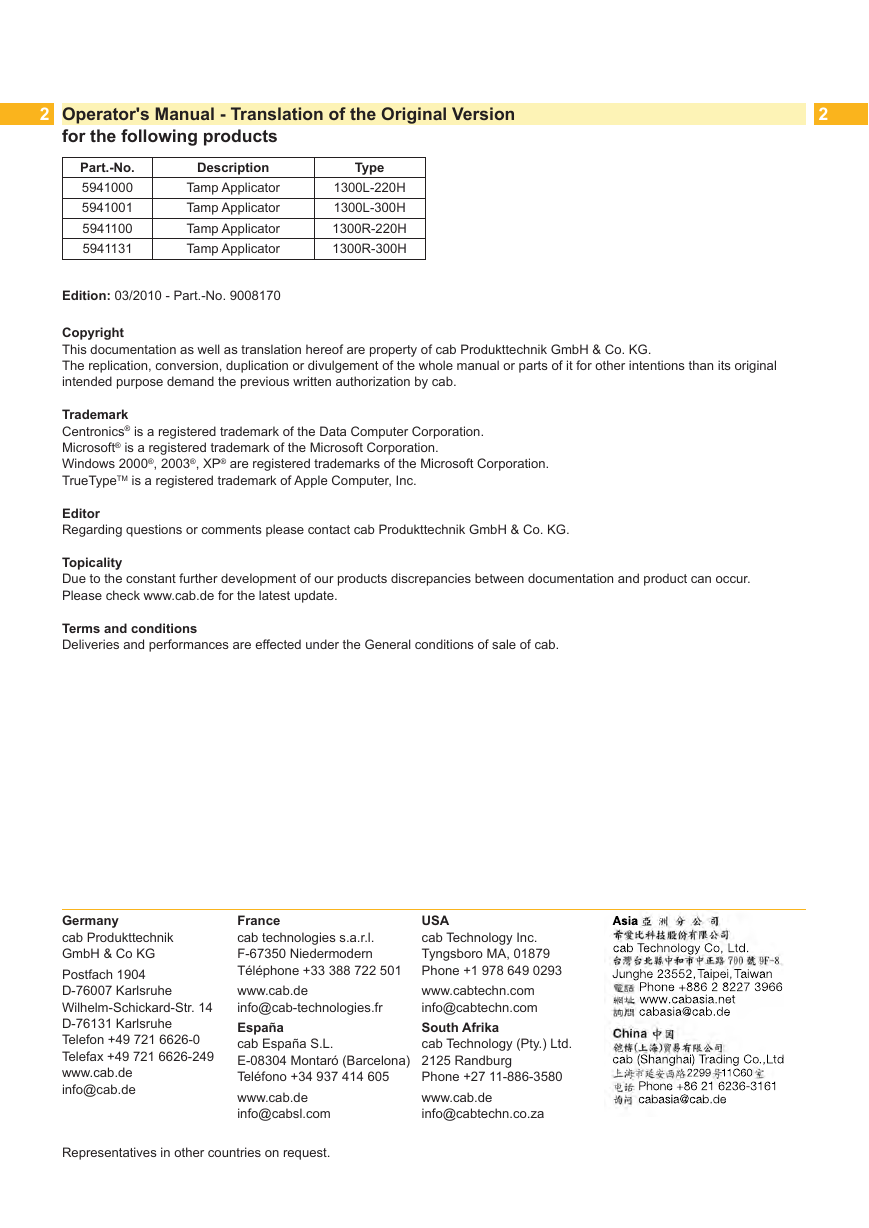
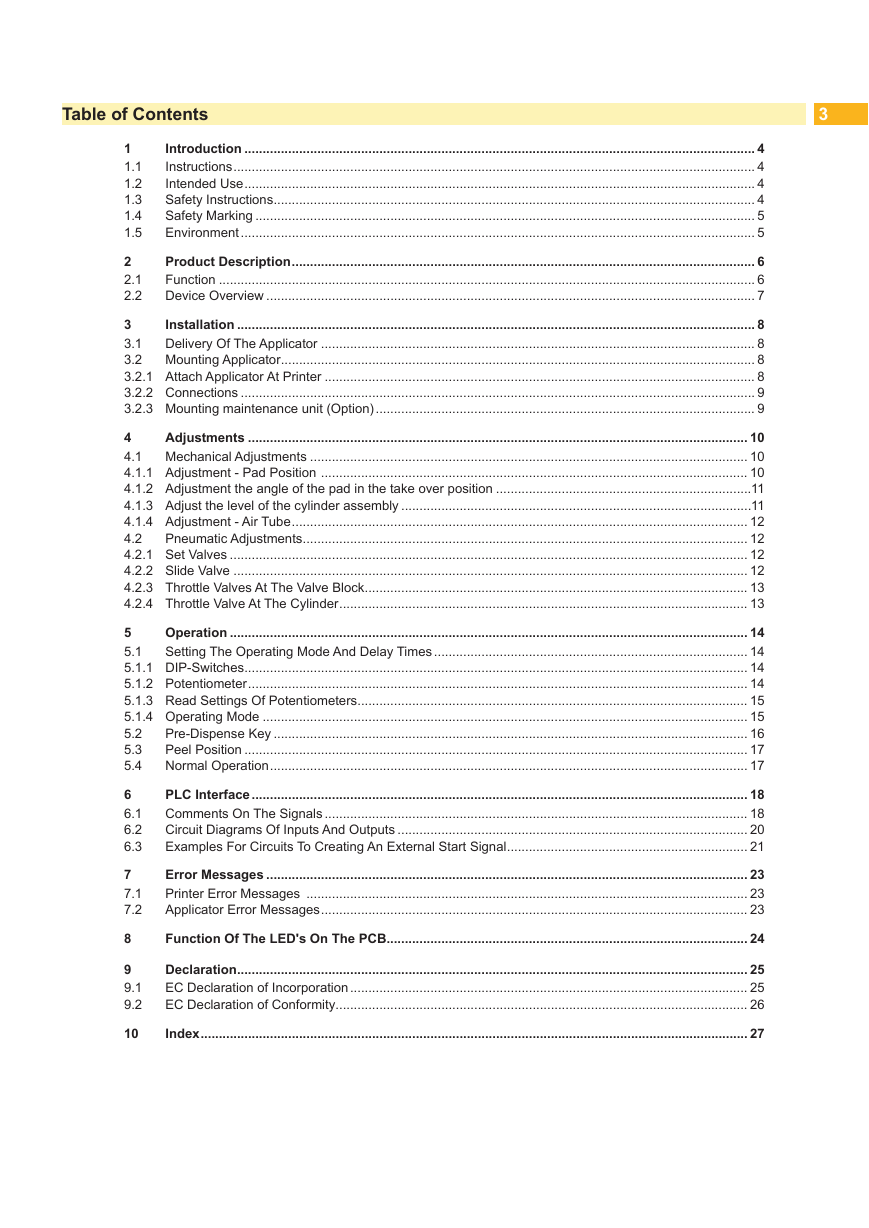
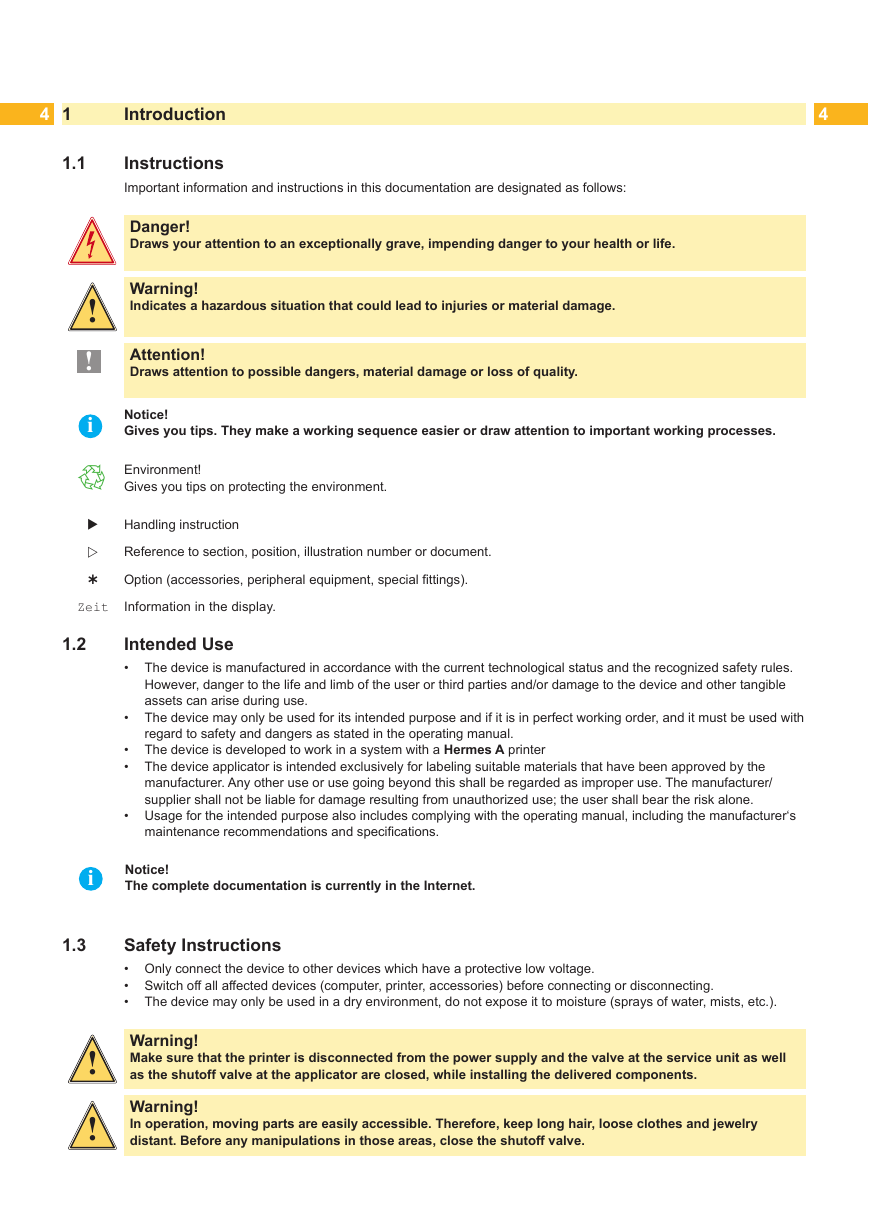
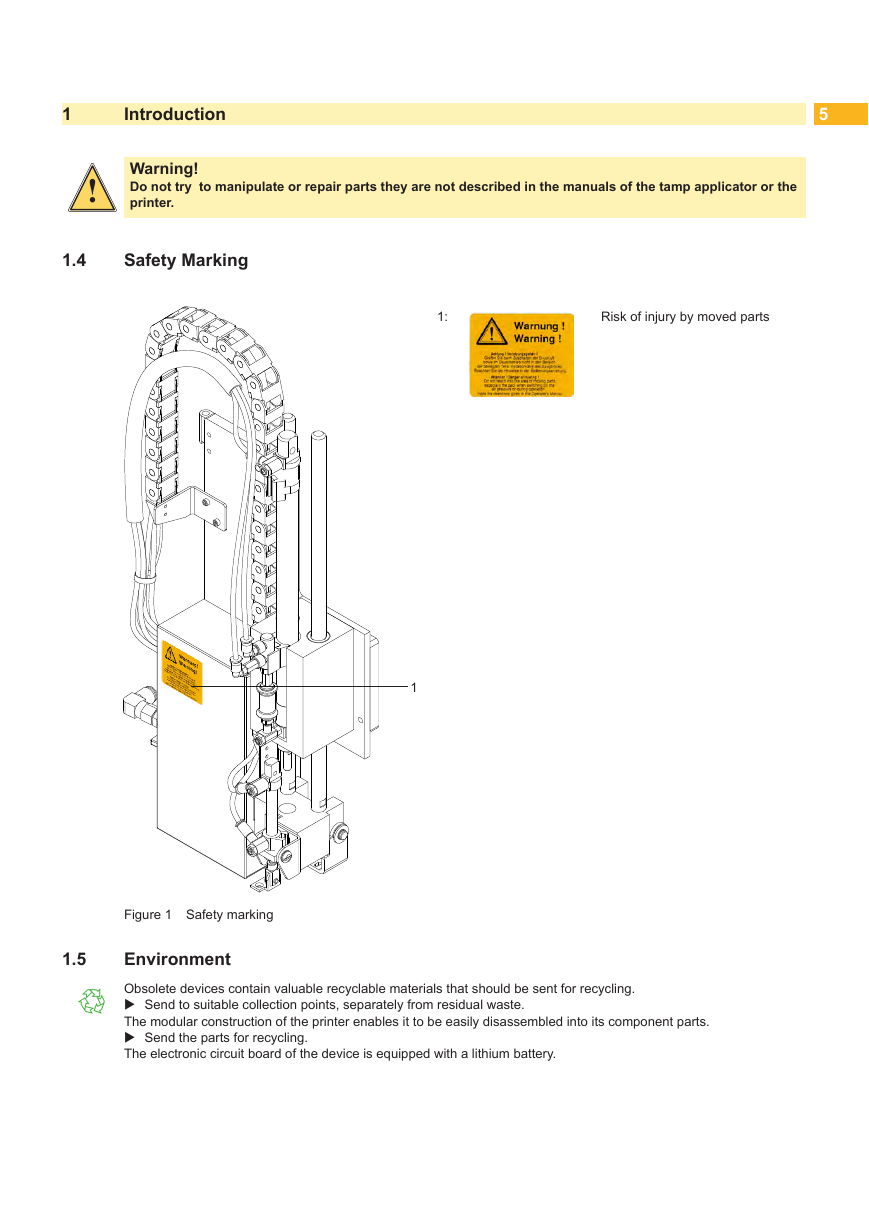
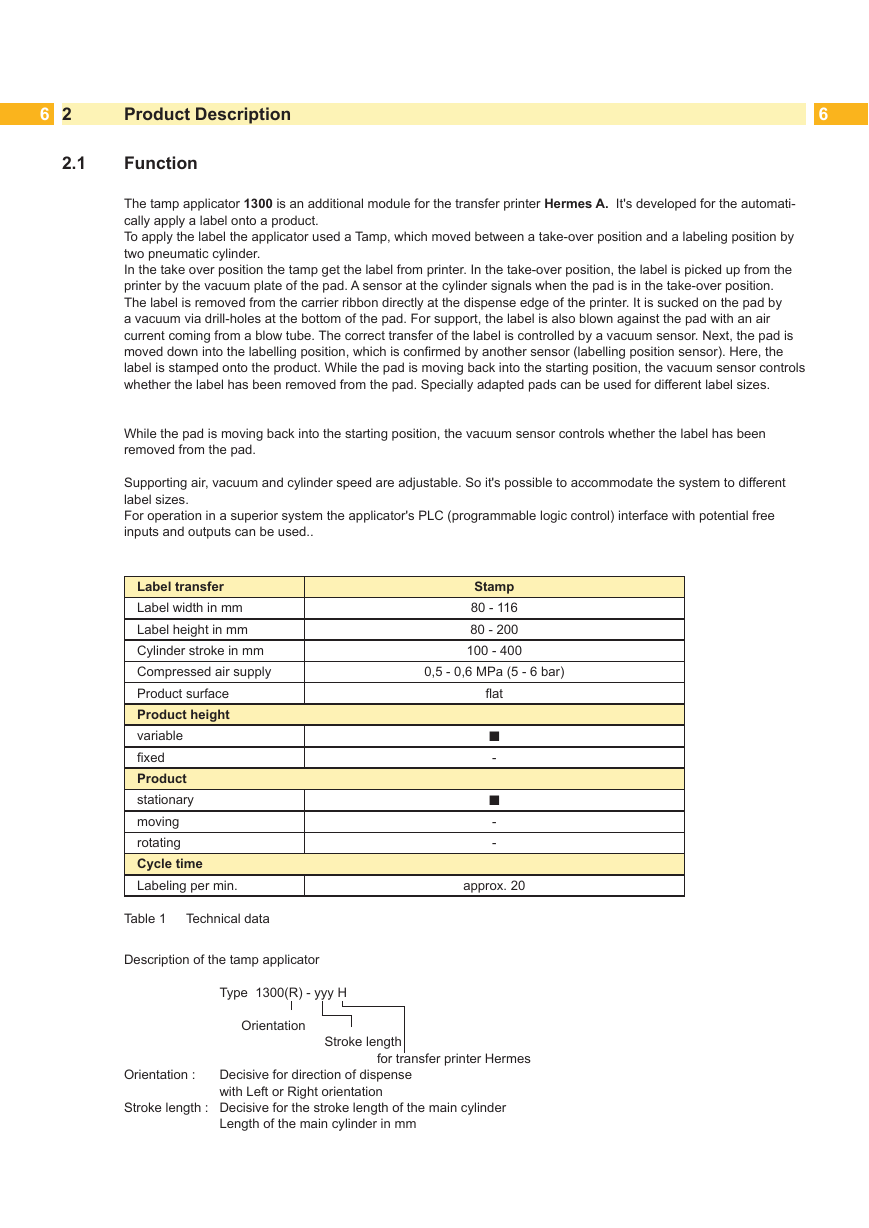
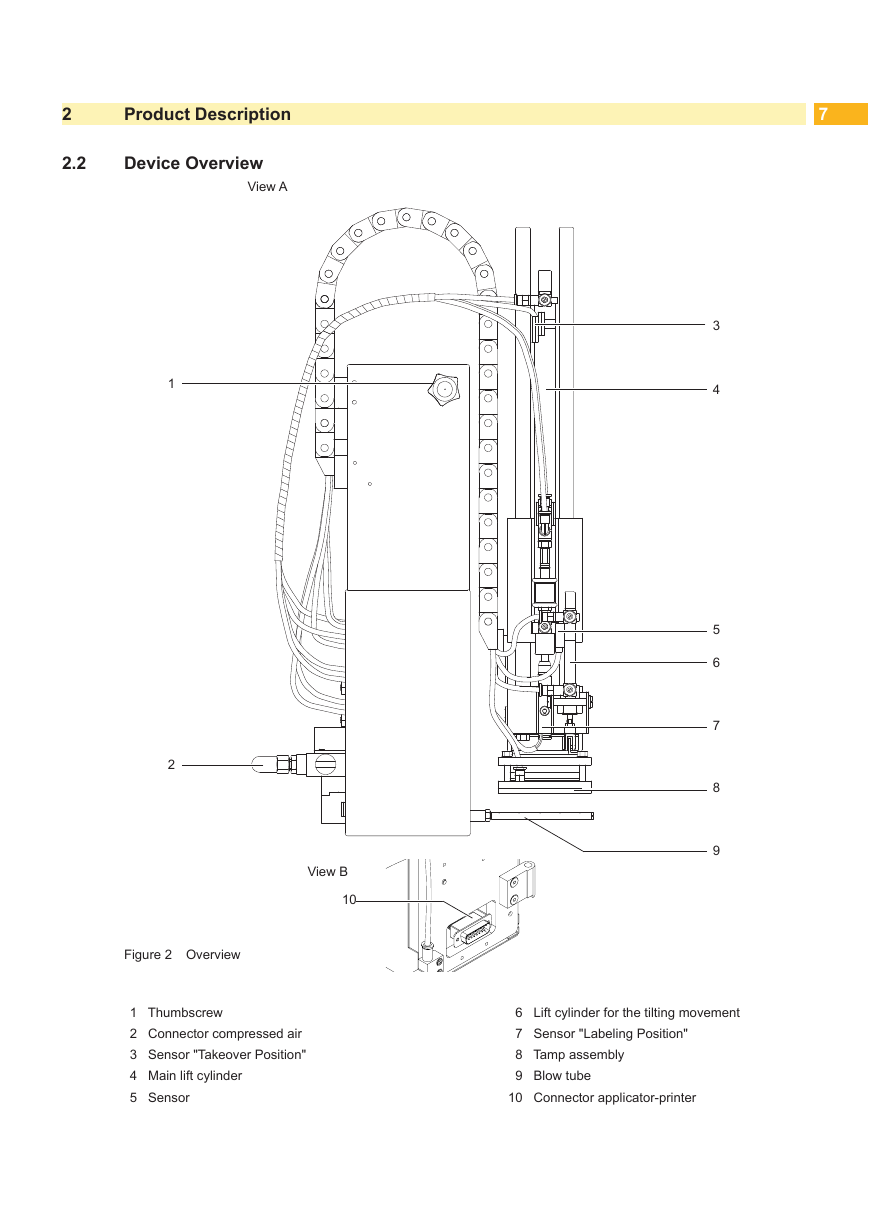
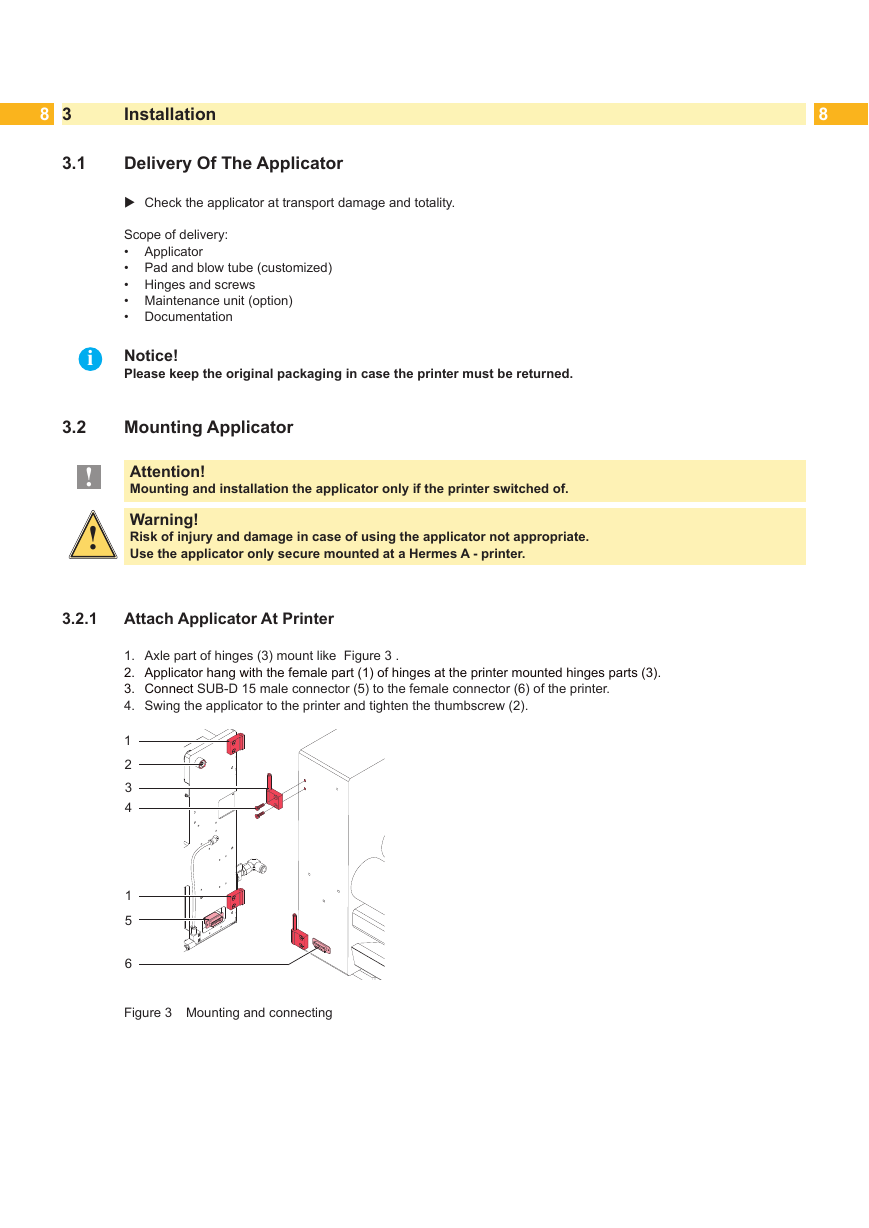








 2023年江西萍乡中考道德与法治真题及答案.doc
2023年江西萍乡中考道德与法治真题及答案.doc 2012年重庆南川中考生物真题及答案.doc
2012年重庆南川中考生物真题及答案.doc 2013年江西师范大学地理学综合及文艺理论基础考研真题.doc
2013年江西师范大学地理学综合及文艺理论基础考研真题.doc 2020年四川甘孜小升初语文真题及答案I卷.doc
2020年四川甘孜小升初语文真题及答案I卷.doc 2020年注册岩土工程师专业基础考试真题及答案.doc
2020年注册岩土工程师专业基础考试真题及答案.doc 2023-2024学年福建省厦门市九年级上学期数学月考试题及答案.doc
2023-2024学年福建省厦门市九年级上学期数学月考试题及答案.doc 2021-2022学年辽宁省沈阳市大东区九年级上学期语文期末试题及答案.doc
2021-2022学年辽宁省沈阳市大东区九年级上学期语文期末试题及答案.doc 2022-2023学年北京东城区初三第一学期物理期末试卷及答案.doc
2022-2023学年北京东城区初三第一学期物理期末试卷及答案.doc 2018上半年江西教师资格初中地理学科知识与教学能力真题及答案.doc
2018上半年江西教师资格初中地理学科知识与教学能力真题及答案.doc 2012年河北国家公务员申论考试真题及答案-省级.doc
2012年河北国家公务员申论考试真题及答案-省级.doc 2020-2021学年江苏省扬州市江都区邵樊片九年级上学期数学第一次质量检测试题及答案.doc
2020-2021学年江苏省扬州市江都区邵樊片九年级上学期数学第一次质量检测试题及答案.doc 2022下半年黑龙江教师资格证中学综合素质真题及答案.doc
2022下半年黑龙江教师资格证中学综合素质真题及答案.doc